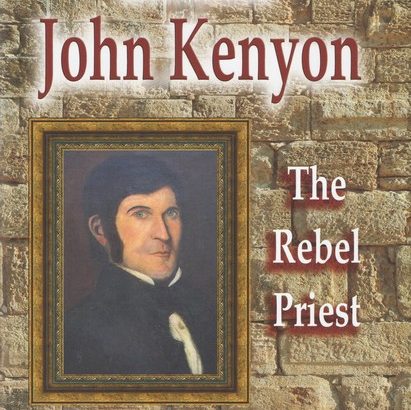Father John Kenyon: The Rebel Priest
By Tim Boland (Published by the author, ISBN: 9781901370362; €20.00 / £17.50)
This is a splendid biography of the mercurial Father John Kenyon, a patriotic priest who should be better known today than he is.
Kenyon was born on May Day 1812 in Limerick city. He was educated locally, entered St Patrick’s College, Maynooth, in 1829. Six years later he was ordained for the Diocese of Killaloe.
He served in a number of curacies: Doora, Co. Clare (1835), Ennis (1835-1838), Silvermines, Co. Tipperary (1839-1842), Ballinaclough, near Nenagh (1842) and Templederry (1842-1847) and was parish priest of Templederry from 1847 until he died on March 21 1869.
From his parish experiences, Kenyon was convinced that the bulk of Irish crime was occasioned by alcohol abuse.
Thus he was dedicated to and a generous supporter of Fr Theobald Mathew and his Temperance Movement.
Enjoying nothing more than organising huge outdoor rallies, he addressed large meetings in honour of Fr Mathew at Toomevara in May 1841 and again at Templederry in August 1847.
Daniel O’Connell was an even more celebrated contemporary. After achieving Catholic Emancipation, O’Connell redirected his mass democratic movement towards winning a repeal of the Act of Union. As a staunch nationalist, Kenyon initially was an enthusiastic supporter of the ‘Liberator’.
However, by the 1840s with little achieved since Catholic Emancipation there was more and more questioning of O’Connell’s leadership and tactics.
This came from a group of radical young men, known as Young Ireland, which was established in 1842 — in imitation of similar movements across Europe, such as Young Italy.
Kenyon in his contributions to the Nation clearly associated himself with them. In a short time the relations between O’Connell and Young Ireland were fraught, to which situation Kenyon and his intemperate broadsides was no small contributor.
Slavery was an issue on which O’Connell and some members of Young Ireland were at variance. O’Connell was unequivocal in his condemnation of slavery and urged the need to extirpate the practice.
Kenyon argued that its evils had been exaggerated by fanatical abolitionists and that Young Ireland should have no qualms about accepting donations from slaveholders in the southern states of America.
In his typical simplistic style — as it would strike many today — he drew a comparison between the slaves in the southern states of North America and the Irish tenant farmers.
O’Connell’s attitude to the use of physical force was epitomised in his comment that there was no political gain whatsoever worth the shedding of one drop of blood.
Kenyon in the Nation trenchantly defended the resort to arms. He even called on the people to secure arms, obviously with a view to using them. Yet when the rebellion he had urged occurred in 1848 he refused to support it in any way.
In the 1860s he was involved in skirmishes between Young Ireland and the Fenians.
As a person, whose vocation required him to uphold personal freedom and the cause of peace and non-violence his radical views on slavery and use of physical force alienated him from the overwhelming majority of his co-religionists.
Kenyon had a brilliant mind, was a remarkable orator and an impressive preacher. His literary skills enhanced the columns of many newspapers, not least the Nation and John Mitchel’s United Irishman.
His arrogance, sarcasm, tendency to denigrate opponents and use of merciless invective indicated a flawed character. This led him to be involved in controversies in local and national affairs.
It also meant that his interventions at national level were negative and destructive to great cost to himself and others.
Charles Gavan Duffy, looking back over the era, summed Kenyon up most aptly, writing that: ”He was a man greatly, but unevenly gifted. With more worldly wisdom he might have been a Swift; with more spirituality and fidelity he might, perhaps, have been a Savonarola.”
However, it should be remembered that Kenyon lived in awful times — the period before, during and after the Famine — when despair, helplessness and death stalked the land and during those years, like his colleagues elsewhere, he worked relentlessly on behalf of his parishioners.



